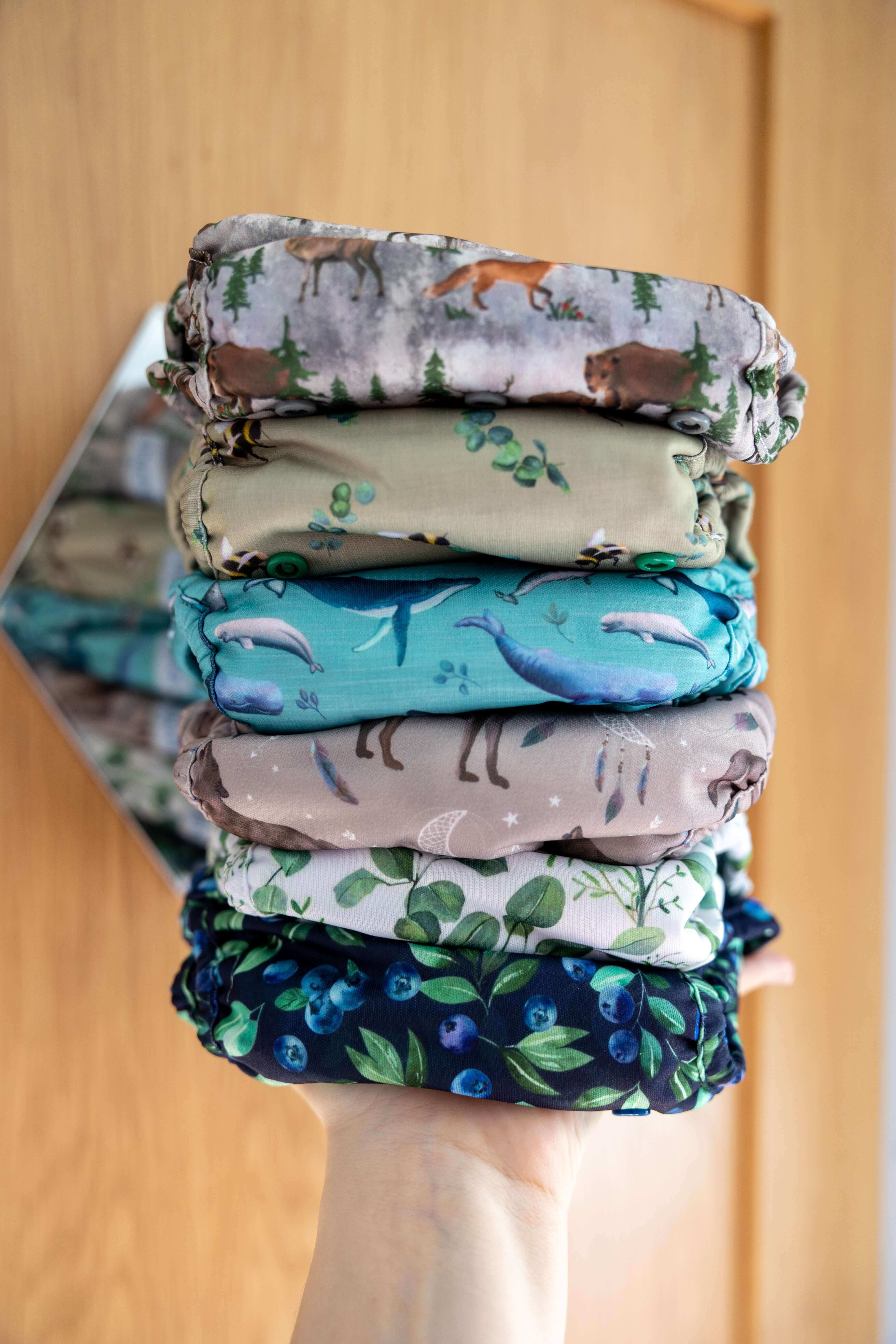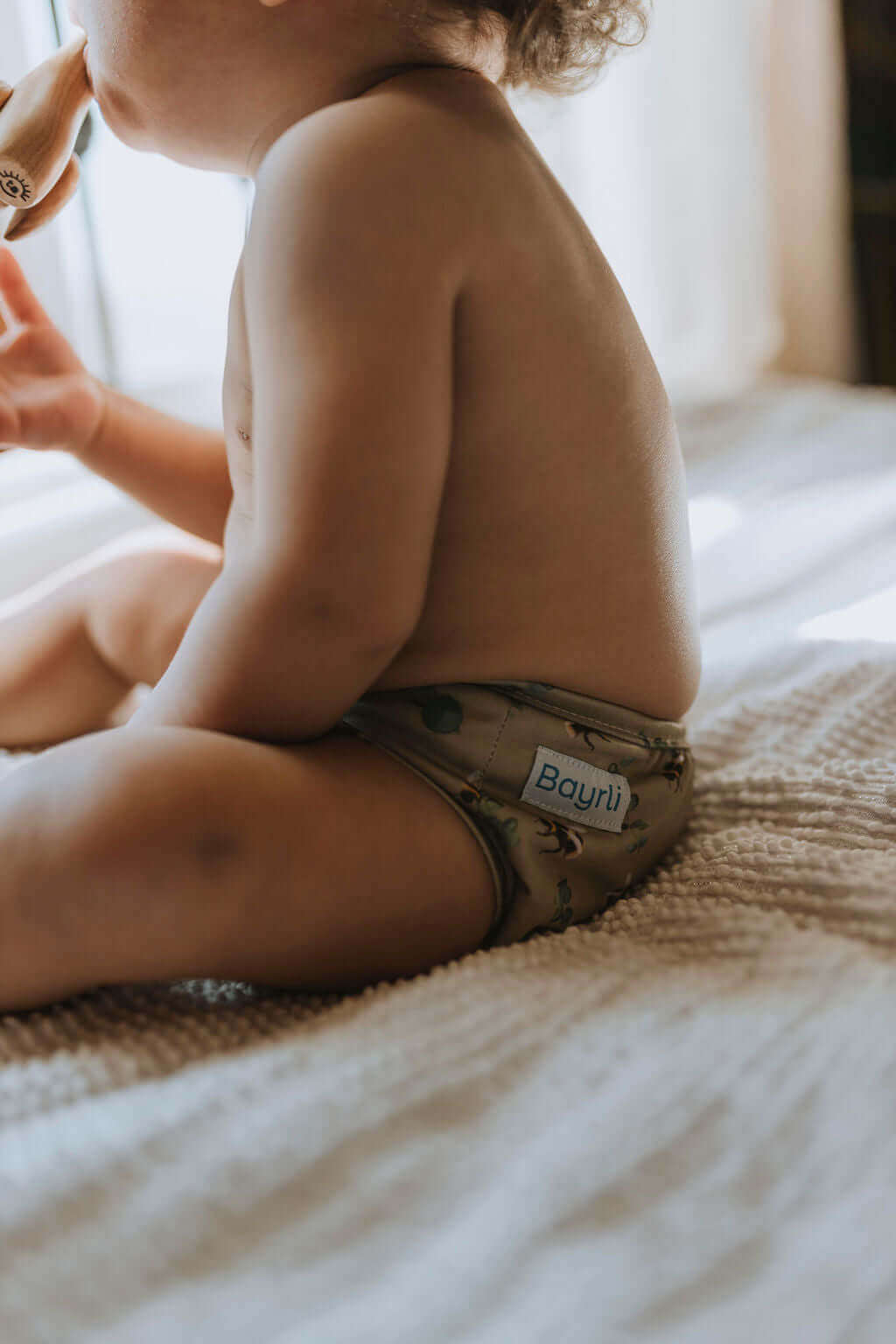
The Pros and Cons of Each Type of Cloth Diaper Explained
There are so many types of cloth diapers available it can all get a little confusing. We at Bayrli want to help you and give you all the pros and cons in one simple, easy to follow guide.
Cloth diaper confusion is prevalent amongst many new mothers and fathers. Today there are so many types of cloth diapers and brands to choose from. The sheer assortment of options available can feel a bit overwhelming.
But don’t worry; you’ve got this and we’ve got you. Our ultimate guide is all you need to understand the pros and cons of each. Read on to become the informed parent who uses cloth diapers with confidence.
All-in-One Cloth Diapers (AIO)
At Bayrli we call these our Deluxe Diapers. They’re a super simple, easy to use All In One (or AIO) option that includes everything you need. All-in-one cloth diapers are one-piece diapers that do all the work on their own without extra accessories or inserts. You can of course add in additional absorbency options if you think your baby requires this, which is why we include a snap in booster. We know as your baby grows their need for additional absorbency grows as well, so you choose if you need the booster or not. AIO diapers have their absorbency layers sewn into the waterproof cover, making diapering your baby quick and easy without the extra step of stuffing in an insert or fastening on two separate diapers.
Pros of AIO diapers:
- Incredibly easy to fit on your baby with built-in fasteners.
- One piece diaper: No need for separate inserts or covers.
- Available in multiple adorable styles, patterns, and prints.
- Good choice for daycares, grandparents, or babysitters as they’re just one piece.
- The closest in style to a single use diaper.
Cons of AIO diapers:
- Due to their design they tend to be the priciest option when it comes to reusable diapers.
- Due to their design, they can take the longest time to dry, since they consist of multiple layers of fabric sewn together.
- Less customizable with absorption. Fitting an insert securely can be a challenge.
All-in-Two Cloth Diapers (AI2)
All-in-two (or AI2) diapers come in two parts: the insert and the cover. They are closer in design to a pocket diaper than an all in one diaper.
All-in-two means that the absorbent insert and the waterproof cover are two separate pieces that need to be snapped together to create a complete cloth diaper.
This style of diaper is handy because you can remove and replace the wet insert without having to change the entire diaper. You simply wipe clean a 'true' all-in-two cover and snap in a new insert. If they have a fleece, suede cloth, or athletic wicking jersey lining, then you should not reuse the cover of the all-in-two if it has become wet or soiled.
Pros of AI2 diapers:
- AI2s are very easy to fit on your baby.
- In some cases covers can be reused if dry since the wet inserts can be removed.
- Doesn’t require fitting and removing an insert from a pocket.
- Assortment of wonderful patterns and prints available.
Cons of AI2 diapers:
- Often the most expensive type of cloths diaper to buy, despite little additional benefit versus an AIO or Pocker diaper.
- Attaching inserts requires an extra diapering step, and is often forgotten until you need to put them on your baby.
- Additional absorbency options are likely too complicated to use.
- Most diapers marketed as all-in-two diapers are not 'true' AI2s as they cannot be wiped clean between uses.
Pocket Cloth Diapers
Pocket diapers, or here at Bayrli they are known as the Everyday Diapers, are an incredibly simple to use and ‘fold-free’ option.
On the outside you will see a variety of incredible patterns or solid prints. On the inside of a pocket diaper you will see a sewn-in lining. This lining is usually made from microfleece, microsuede, athletic wicking jersey (AWJ), or can even be made from natural fibers such as cotton, bamboo, or a mix of these materials. A pocket diaper has either one or two openings at the ends of the diaper.
There are several types of cloth diaper inserts to choose from, including microfiber, cotton, organic cotton, hemp, and bamboo and blends of these materials.
Pros of Pocket diapers:
- No folding required: these are easy to fasten on baby and fit securely.
- They don't require a separate diaper cover.
- Easy to customize: stuff with one or two inserts for extra absorbency.
- You can choose to stuff as you go or stuff the diapers in advance to grab-and-go.
- Slim fitting and easy to learn, so they’re great for travelling and childcare.
- Cheaper than AIOs.
- Dry quickly because you can separate the shells from the inserts.
Cons of Pocket diapers:
- The diaper is more than one piece and requires separate inserts, so you must remember to fit these inserts prior to fastening on your baby.
- Whilst rare, some babies are sensitive to stay-dry materials used in the lining of pocket diapers.
- Pocket inserts take longer to dry than Flats and a Diaper cover.
Fitted Diapers
Fitted diapers must be paired with a Diaper Cover. Our version is a Bayrli Inner paired with a Bayrli Outer. The inner absorbent fitted part holds all the urine and solids whilst the outer waterproof cover prevents leaks and blowouts. They’re easy to fit on your baby with elastic leg holes and snaps to secure in place. The inner diaper gives your baby full-coverage and long lasting absorbency. Once the inner fabric diaper becomes soiled you simply replace and can reuse the outer waterproof cover.
Pros of Fitted diapers:
- Remarkably easy to fit on your baby.
- Super absorbent and great for night use.
- Incredibly long lasting such as the Bayrli Inner.
- Covers can be reused since inner diaper layer can be removed, simply wipe it clean.
- Inner diaper provides full-coverage absorbency.
- Can include additional boosters like the Bayrli Inner to customize absorbency.
Cons of Fitted diapers:
- More expensive compared to basic flats and pre-folds.
- Two pieces makes diapering a two-step process.
- Due to their absorption properties, the multiple layers of fabric in the inner diaper can take longer time to dry.
Flat Cloth Diapers
Flats or Flat diapers are considered the original cloth diaper. Ask anyone who was around in the 1960s-1980s and this is the reusable diaper that will come to mind. Much like its name, a flat diaper is a singled-layered piece of fabric that’s usually made of cotton. To fit on your baby, it requires folding in a variety of ways to create a multi-layered, diaper-like shape. The type of fold is entirely up to you. To secure flat diapers you will need a dedicated diaper pin, clip or snap. And don’t forget the cover to prevent against leaks.
Pros of Flat diapers:
- The most inexpensive cloth diapering option of them all and incredibly long lasting.
- Can customize absorbency by layering more than one flat together or adding a booster.
- Easy to adjust as baby grows and you choose the fold you need.
- Multi-use around the home: Can be used as burp cloths or breastfeeding covers as well as changing mats.
- Extremely fast to dry.
Cons of Flat diapers:
- Require origami-like folding skills to get a snug fit, and this takes time master.
- Need diaper pins, clips, snaps, or fasteners to secure.
- Must use with a separate cloth diaper cover.
- Can be a challenge for childcare as there is a steep learning curve.
Prefold Cloth Diapers
Prefold diapers are very similar to flat diapers, but are pre-folded into three panels with the middle panel being the most absorbent. Just like flats, prefolds sometimes require snaps or clips for fastening and a diaper cover to help prevent against leaks and blowouts. Because prefolds are already layered they give that extra assurance against leaks and they can be a faster alternative to a flat diaper, while still being low in cost.
Pros of Prefold diapers:
- Relatively low in cost, just like flat diapers, and indestructible.
- Already layered in the center, so can be a faster alternative to a flat diaper.
- Adjustable as your baby grows depending on size.
- May be fastened around your baby or simply placed into a diaper cover.
- Can be tumble dried.
Cons of Pre-fold diapers:
- May still need to fold into a diaper-like shape to fit baby.
- Need diaper pins, clips, snaps, or fasteners to secure.
- Must use with a separate diaper cover.
- Again, this option can be difficult if your baby goes to childcare due to the learning curve.
If you still have any questions about different reusable diaper types or styles, just let us know and a member of our team will do everything to help you out!


